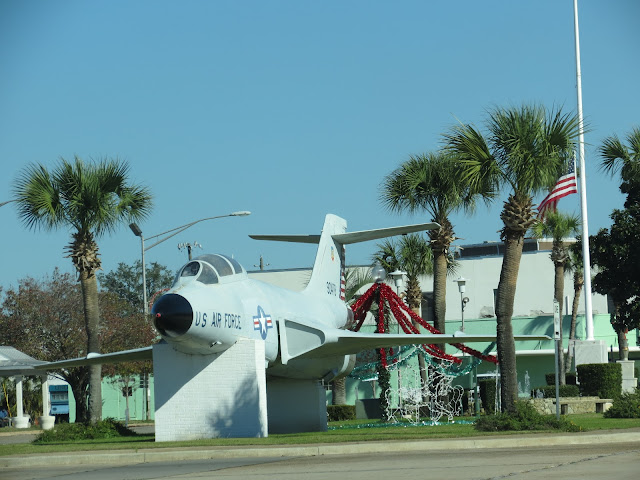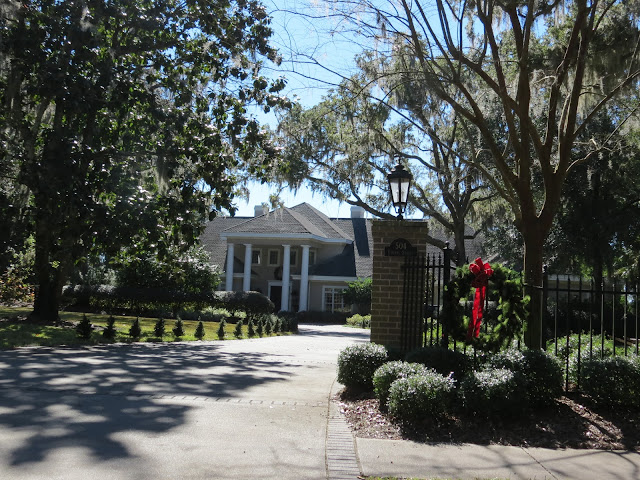Looking for Liz? I've started a new blog for 2013. You can find me here:
http://wheres-liz-2013.blogspot.com
Where's Liz-2012?
"Seek ye first the kingdom of God, and his righteousness, and all these things shall be added unto you." (Matthew 6:33)
Tuesday, January 1, 2013
Sunday, December 30, 2012
St. George Island State Park and nearby places
The first thing you notice as you cross the bridge to St. George Island is the lighthouse.
And the next thing you notice is all the fresh seafood vendors. Nan has experience in that department and I'll tell you the grouper, shrimp, and crab cakes were all delicious.At the state park, the beach was wonderful, strewn with seashells.
I learned some more about the turpentine industry along one of the hiking trails.
Almost all of the pine trees showed the V-shaped scars of resin gathering.THistle and I hiked the 5-mile trail through the slough to the beach and back.
Like Moses, Thistle only got to see the promised land....he wasn't allowed on the beach here.
THe sand dunes are white as snow...or sugar.Ripples of clouds over the dunes.
A lone pied-billed grebe in a pond.
Back to the beach just before a storm front moved in....surf's up!
Nan, trying to roll this log back out to sea.
Terns were diving into the surf, but too fast to catch that act on camera.
This crab was sitting all comfy in the sand until Nan decided to poke at him with a stick.
Then he got all crabby.
One day we took an excursion to the mainland to tour some historic state parks. This one commemorates the Constitutional Convention, which met in Saint Joseph to draft the first Florida Constitution in preparation for statehood.
Inside the museum, exhibits portrayed the history of Florida leading up to statehood.There was a lot of competition for the location of the convention.
The museum even had a Disney-like living-diarama of the occasion. At the press of a button, the figures become animated and you can listen to the discussion.
St. Joseph was becoming a prominent resort town when a series of events precipitated its demise....yellow fever, a devastating hurricane, and a wildfire.
Our next stop was the Orman House, an 1838 antebellum home built on a bluff overlooking the Apalachicola River. Cotton lines the walkway.
Federal and Greek Revival Styles, according to the brochure. The house is now preserved as a state park.Behind the house, the remains of a slave cabin.
A sign about the twenty slaves owned by the Orman family.
How thrilled they must have been when the slave cabin was wired for electricity!
A look inside the Orman house:....the parlor,
A downstairs bedroom,
The dining room, etc.
Meanwhile, back in McIntosh, the sun still rises over my site.
But I will have to say goodbye to my winter site. My site is having problems with electric power, and the owners say they can't fix it, so I have decided to move to a different RV park for the month of January. I will miss my sunrises and the red-shouldered hawk that greets me each morning.
Monday, December 24, 2012
Touring Panama City and Camp Helen State Park
Nan and I took the car and toured some sites around Panama City.
This huge wheelbarrow was the sign for a community garden.
Nautical Christmas lights.
Shrimp boat.
This park has quite a light display at night, but we didn't come back after dark.
In the historic district, one man's garage reflects some history.
Some of the historic homes, decorated for Christmas...
Historical marker at the shore.
The historic homes were built on a bluff across the street from the beach.
911 Memorial
A bench for each hijacked flight.
After our driving tour of historic Panama City, we visited another historic site at Camp Helen State Park.
Camp Helen is a day-use park with beaches, kayaking, and hiking trails, but our visit was confined to the historic buildings.
After the death of Robert Hicks, property was opened for paying guests who stayed in newly built cottages. Later after the property was sold to Avondale Textile Mills, the house became a lodge and the property was used as a retreat for employees.
A peek in the window.
A ranger came along and opened the house for a tour. This is the modernized (1950s era) kitchen.
Each room has a fireplace.
Built-in hutch in the dining room. The wood for the lodge was imported from Brazil.
Downstairs is a living room, kitchen, dining room, bedroom and bath.
Upstairs are three rooms and 3 baths.
Telephone alcove.
Upstairs is the bride's room which is used when the home is rented for weddings.
And the groom's room.
Our guide discovers an uninvited guest...a squirrel has chewed through the wall above the mantel. We can see a nest it's been building inside the wall.
A portrait of the Hick's daughter, Margaret, wearing her riding clothes.
A description written by Margaret Hicks, sharing some of her memories of living here.
Indoor balcony off the groom's room.
Living room.
The four Rainbow Cottages were added in the latter 1930s.
The caretaker's house was first used by the Hick's caretaker, and later by Avondale's camp hostesses.
The backside of the kitchen used to have an attached dining area, no longer there.
The water tower provided adequate water pressure for the complex.
The kitchen was first used as a general store and later as Camp Helen's kitchen.
The two-horse stable was built of lime rock by the Hick's family.
Stable
A storm was predicted, so we did not take the trail to the beach.
I'm making my Florida Parks pass pay off by visiting nearby State Parks free. Next post will be two more historic state sites in the area.
Subscribe to:
Posts (Atom)































































































